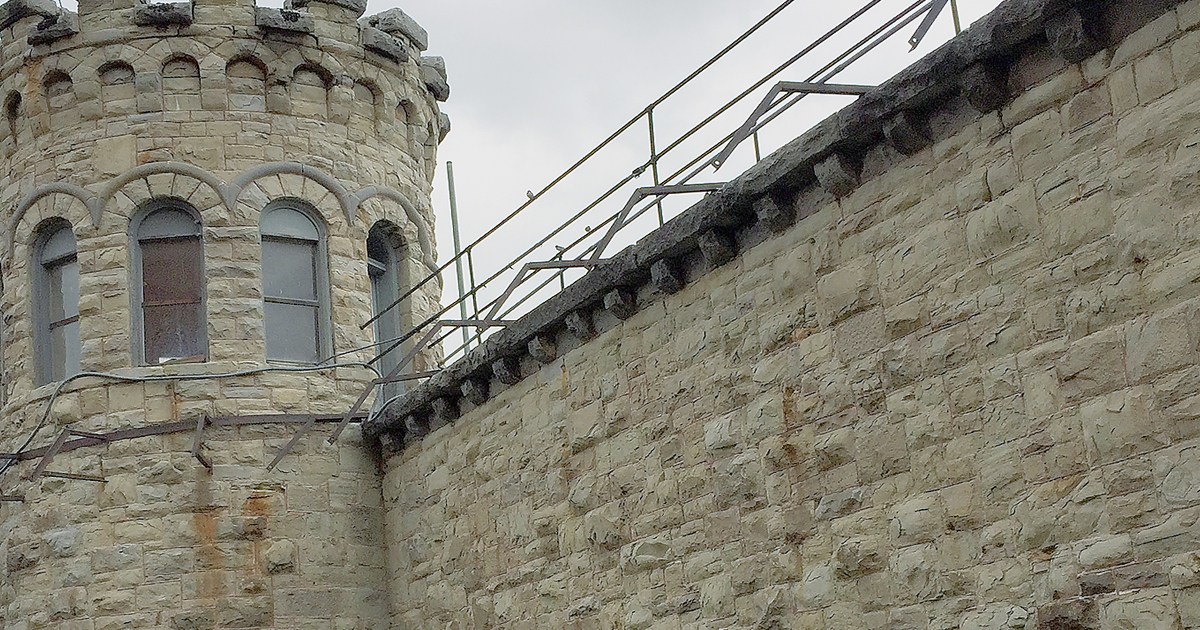For those who are weary of hearing about building a wall, I have good news. Montana’s wall was finished in 1893, 126 years ago.
Many of us still haven’t gotten used to it.
When one exits Interstate 90 at Deer Lodge, instead of finding a garden variety Montana Main Street, travelers are startled to see, right in the middle of town, a towering sandstone wall with turreted corners. This barrier is not a castle. It’s not a medieval fortress.
It’s Montana’s Old Territorial Prison.
The no-nonsense facility sends a chill down today’s visitor’s spines, as it surely did in those sentenced to live behind the iron bars of its cold, dark cells more than a century ago. Considering Montana history, however, when the prison opened in 1871, it was likely a step up from Vigilante justice, administered at the end of a rope.
Events coordinator, Heather Gregory, calls visiting the Old Prison an unforgettable experience. She said, “It’s like stepping back in time, a place of pure Montana history, from the 1800’s up to 1979.”
Gregory’s enthusiasm for the guided daylight tours of the prison is catching. One may use the self-guided tour book, but visitors hear more stories, see more things, and feel closer to what it was like to be doing time while they spend time with the guide.
For example, Gregory may send visitors into the dungeon, and shut the door.
“That’s the best way to get a feel for what it was actually like,” she said.
The night tours, which focus on the paranormal, and the Lockdowns, are not for the faint of heart. They require a lot of planning and preparation on the part of staff, but they are loads of fun and sell out almost as fast as they are posted.
In the Lockdowns participants spend 12 hours living an early 1900’s convict’s life.
People who have no interest in the paranormal reveal some interesting reactions after visiting the Old Prison. They report having strange sensations that prevented them from entering maximum security, or just admit that they felt scared in certain areas. Gregory hears things like, “We were the only ones in the cell block, but it felt like someone was watching us.”
This intimidating barrier, completed in 1893, is bullet scarred from the 1959 riot, but still standing firm after more than a century. Gregory insists that it’s sturdier than the more modern buildings in town.
Convict labor built the stone wall 24-feet high, 3-feet wide at the top, and 4.5-feet wide at the bottom. It extends four feet underground.
Nearly all of the buildings on the prison grounds are inmate built. Prisoners handmade over a million bricks. They quarried granite slabs, cut timbers, and dug out the lime used to make concrete.
Warden, Frank Conley, who served from 1890 until 1921, longer than anyone else in that post, believed that the incarcerated ought not to be idle. To work was a privilege that gave low-risk inmates the opportunity to live outside the walls, usually in a camp setting.
Infractions quickly landed a man back in a cell. Those thought to be at risk of running wore shoes with concrete soles that weighed around 20 pounds each.
Under Conley, the prison was a self-sufficient community that raised its own meat and produce and made its own baked goods. Inmates supported a garment factory, a furniture factory, and a laundry. Prisoners were sent out to construct more than 500 miles of Montana roads, build houses, and work on farms and ranches.
Many considered the Montana Prison a model institution that sold products and produce to buyers outside. Conley’s plan relieved overcrowding in the inadequate facilities because more than half the population worked and lived outside the wall. It relieved money problems when the state paid only about 71 cents per inmate for their first 100 days, and then one dollar per day after that.
Conley was fired in 1921 after community complaints of his using prisoner labor for his own financial gain. His model left with him. In addition to the firing of Conley, Montana workers objected to prisoners taking jobs away. Overcrowding, inadequate funding, unprofessional wardens, and untrained workers created unbearable conditions that resulted in unrest. These were a contributing factor that led to the riot in 1959, even though reforms were being implemented by then.
This summer the Old Prison Museum staff plans to re-enact the deadly riot. Deputy Warden Theodore Rothe was killed by those trying to escape, and Warden Powell was held hostage. The National Guard was brought in, and after three days of mayhem, one instigator killed the other and then himself.
The 1959 riot was the first serious disturbance since a failed escape attempt in 1908 left Deputy Warden John Robinson dead and Warden Conley with extensive stab wounds on his back and neck. The two responsible prisoners were hanged in the prison yard. They were the only individuals executed within the walls.
If the walls could speak, they could tell more amazing human stories.
“Every year people come forward with stuff or stories from relatives that were inmates or guards. They give us even more insight into what it was like,” says Gregory.
A new display this year reveals a tragic and unjust season in Montana. Forty-one men were incarcerated under the sedition laws from 1918 to 1920 for disagreeing with the government. These people were sentenced from one to 20 years for simple comments that are mild, compared to what we hear people say in protest today. The exhibit tells how families were broken, children taken to institutions, homesteads lost, and more.
Better late than never. Governor Brian Schweitzer pardoned them in 2006.
The state of Montana owns the Old Prison Museum, the Powell County Museum and Arts Foundation leases it. They receive no federal or state funds, so rely on memberships, donations, fees, and grants to keep the place running.
Admission for adults is $15; seniors, $12; children ages 9-15, $8; and those under age 8 get in free. The admission includes visiting the prison and four other excellent museums. If you can only take in a couple of venues, hang on to your receipt, and come back another day. The ticket is good for a year. Most, but not all, of the buildings at the Prison are accessible, but visitors should be prepared for considerable amounts of walking on uneven ground. I tripped on some broken pavement and fell hard. It was almost like someone gave me a shove.
Oh, wait…did I say that? MSN
Plan Your Trip to Include Other Museums and Historic Displays
Deer Lodge is home to an astonishing number of museums and historical collections for a town of its size. The Old Montana Prison Museum is one of the five sponsored by the Powell County Museum and Arts Foundation.
The Montana Auto Museum displays around 170 classic cars ranging from 1855 through the muscle cars of the 1970s. They’re all indoors, and the area is fully accessible. Music popular during the era of the cars in each bay takes listeners back to that day.
Heather Gregory, events coordinator for the Old Prison Museum, likes to hand out towels before she takes people to see the Classic Cars.
“You’ll be drooling before we’re done,” she jokes.
Yesterday’s Playthings, across the street from the Wall, displays toys from way back, including working toy trains. Grandchildren get a kick out of seeing what was popular when Grandpa was a kid.
The Frontier Museum has an outstanding WW I exhibit and one of the largest black powder weapons collections in the Northwest.
The Powell County Museum tells stories of the valley, including Cottonwood City, where one may watch a live blacksmith at work with iron and fire.
Right next to the Old Prison is the Prison Cow, a refreshing stop with multiple flavors of Montana–made Wilcoxson’s ice cream.
Just beyond the Prison Cow is an outdoor exhibit of Little Joe, an electric engine built by General Electric for Josef Stalin’s Trans-Siberian Railway. Delivery was blocked during the Cold War, so the Milwaukee Railway snagged the bargain-price engine and used it between Harlowton and Avery, Idaho. Little Joe refers to Stalin.
At other end of town is a National Historic Site, the Grant Kohrs Ranch. Visitors get a look at cattle ranching in Montana’s earliest days. They will get a taste of the rough-and-tumble life of a cowboy and see how a woman’s influence brought culture and refinement to the frontier. MSN











